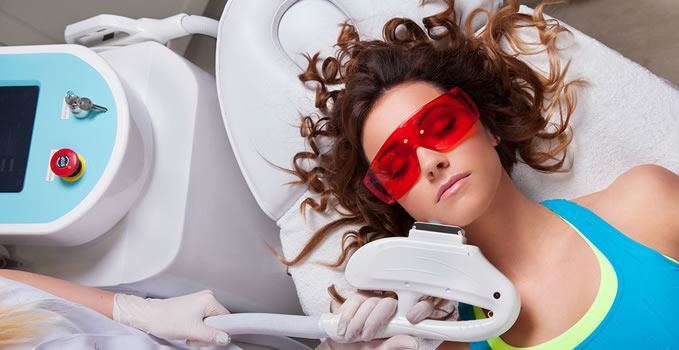Where is the Alexandrite Laser Used?
Alexandrite lasers are powerful equipment and should only be used by a trained practitioner, therefore they are often used in hair removal salons. There are currently No FDA approved home laser hair removal devices that contain the Alexandrite laser
What is the Alexandrite Laser?
An Alexandrite Laser is a type of LASER (light amplification by stimulated emission of radiation) that emits high energy light through an alexandrite crystal. As the light passes through the alexandrite crystal, a beam of light 755 nm long is produced.
Note: The length of the beam of light determines how far into the skin the laser penetrates.
The color of the laser light is red.
Alexandrite Lasers can be set on Q-switching mode, which causes the laser to produce a high-energy beam of light in short pulses. This is what makes it effective for hair removal.
In addition to hair removal, Alexandrite Lasers are used for:
- Treating age spots
- Treating spider veins
- Treating vascular birthmarks
- Tattoo removal

How is it Different from Other Lasers?
What is the difference between the Alexandrite Laser and other lasers? Aside from the color, the wavelength of the light is the only thing that changes.
For example, the Alexandrite Laser emits a red beam of light that is 755 nm. A diode laser, on the other hand, emits a 810 nm laser beam and a YAG laser emits a beam at 1064 nm.
Wavelength Comparison of the Different Lasers
| Laser Type | Wavelength | Suitability |
|---|---|---|
| Argon | 488 nm or 514.5nm | No longer used for hair removal – the device was tedious and ineffective for hair removal |
| Ruby Laser | 694.3nm | Effective and safe on patients with light, pale skin |
| Alexandrite | 755nm | Safe and effective on all skin types (from 1-7 on the Fitzpatrick scale) |
| Pulsed Diode Array | 810nm | Effective on pale to medium skin (I up to IV on the Fitzpatrick scale) |
| Nd:YAG Laser | 1064nm | Specifically made for darker skin types, though effective on all skin types |
| Intense Pulsed Light | 500 to 1200nm | For pale to medium type skin (this is not a laser but is still used for hair removal) |
Advantages of the Alexandrite Laser
It is considered the most efficient laser for use with all hair and skin types, as the laser does not affect darker skin types as much as other lasers. As with all other lasers, it is best with white and very light skin, and has proven most effective with the fine, thin hairs that many of the other types of laser cannot eliminate.
The wavelength of light emitted from the Alexandrite Laser is easily absorbed by the melanin (pigment cells) in your hair, which causes those cells to be heated and ultimately destroyed.
Note: For very dark skin types, the best option is the Nd:YAG laser, as the beam’s extra length will penetrate the hair follicles without affecting the skin pigment as much.
Alexandrite Laser Effectiveness
With the Alexandrite Laser, there is a hair clearance rate of roughly 70% after the recommended number of treatments–usually between 6 and 8 for thinner hair, or 8 to 12 for thicker, darker hair. See clinical studies for more information on hair reduction effectiveness.
It is also considered the fastest of the lasers, removing large swaths of hair in fewer sessions. For patients interested in treating larger body areas (such as the stomach, chest, back, shoulders, or legs), it’s often recommended to use the Alexandrite Laser.
Alexandrite Lasers are one of the only lasers recommended for treating hypertrichosis, also known as “Ambras syndrome”.
Alexandrite vs. Diode Lasers
One of the most popular types of lasers for laser hair removal is the pulsed diode laser, which has a beam only slightly longer than the Alexandrite Laser.
In a 2001 study [1], the two lasers were compared to see which produced the best long-term results. Alexandrite Lasers caused hair growth to be reduced by 85%, while diode lasers only produced an 84% reduction. Four treatment sessions with both lasers caused a 90% reduction in hair growth for up to 12 months.
In 2006, a study was done into the effectiveness of the two lasers, and it was found that both lasers did the job with equal efficiency. However, diode lasers were more likely to cause side effects, with a 28.9% chance of problems compared to the 9.5% chance with Alexandrite Lasers.
Side Effects

Are there side effects of using the Alexandrite Laser? Unfortunately, as with all lasers, there are some side effects.
For those with very dark skin, there is a risk of hypopigmentation (skin lightening in patches that are treated by the laser). The Alexandrite Laser is NOT the most effective for dark-skinned patients, as mentioned above.
Even among those with lighter skin, there is a risk of the pigment being destroyed from the skin. On the flip side, there is even a risk that the skin will OVER-produce melanin as a result of the light, which could lead to dark patches on your skin.
Pain is common during the treatment, though it’s usually fairly minimal. A cooling gel is often applied once the area is treated, helping to reduce pain and prevent swelling.
There is often a bit of swelling and itching following the procedure, but that should go away after a few days. The skin may turn red, but it will only burn if the laser is incorrectly used.
There is a very small chance (10%) that there will be bruising, but the bruises will fade on their own.
Post time: Jun-01-2021
